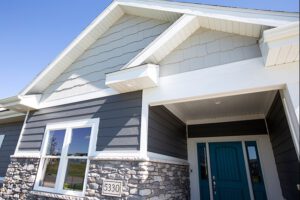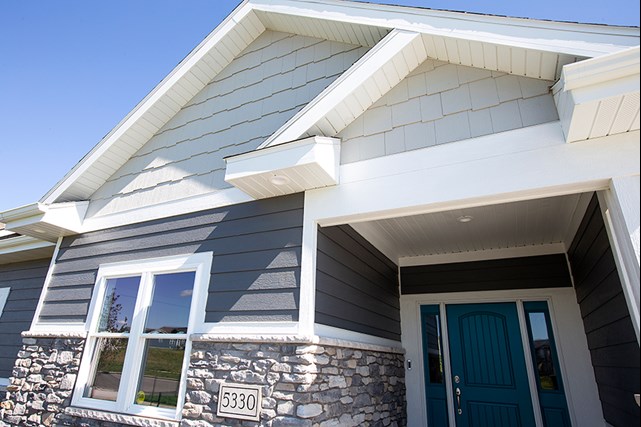Siding is your home’s final layer of protection that keeps moisture from getting into the walls. Several types of siding are available for your house, and each offers a different aesthetic value.

The best siding to choose is one that is durable and low maintenance. Wood clapboard is one such option. However, it must be stained or painted every two to three years and can become expensive in the long term. For professional assistance, contact Top Notch Roofing/Siding now!
Many homeowners choose fiber cement siding for their homes because it looks like natural wood but lasts much longer. It also requires less maintenance than traditional wood or vinyl, making it an affordable and eco-friendly option. It is also fireproof and designed to withstand natural disasters. Its durability also helps save energy, which can lower utility bills. It is available in a wide range of colors and textures to match any architectural style.
Fiber cement siding is made from cellulose fibers, Portland cement, and sand. It is pressed into molds and can be made to look like wood or come in several textures. It can be stained, painted, or left natural. It can also be fabricated into long planks, blocks or shingles. Fiber cement siding is also made into architectural trim pieces to add character to your home’s exterior.
This type of siding is very durable and resists moisture, rot, and pests, especially termites. It is also unaffected by the corrosive salt air that exists in coastal regions. Additionally, it is able to stand up to high winds and strong UV radiation.
It is also a good choice for arid climates because it can withstand wildfires, and some insurance companies even offer discounts for homeowners who choose this material. It has a Class 1A fire rating, which means it can resist the spread of fire and reduce damage to other buildings nearby.
Unlike natural wood, which can rot and become damaged by insects, fiber cement is a long-lasting and durable material that will protect your home for decades. It is resistant to rot, fungus, and other environmental hazards, and it comes with a 50-year warranty. It can also withstand extreme weather conditions, including hail and high winds.
Choosing the right exterior siding for your home can be difficult, but it’s important to take time to consider your options. You should take time to read architectural magazines, browse the internet and use social media to get a feel for the different styles. It’s also a good idea to drive around your neighborhood and take note of which homes appeal to you. You can then share these ideas with your architect, HOA, or builder to help narrow down the options.
Manufactured wood
Manufactured wood siding is a composite material made of strands or fibers of wood, combined with resin and pressed together. It is often painted to look like natural wood, so it looks very similar to traditional wooden exteriors. It is also much lighter than natural wood, making it an excellent choice for modern homes. However, it is not immune to moisture damage, and can degrade quickly. This type of siding requires a good coating and regular maintenance to maintain its durability.
A reputable contractor will work with you to ensure the product and installation are within your budget. They will help you determine which product is best suited for your house and its location. They will also recommend any additional components that you may need, such as trim or eaves. They will provide a detailed quote that includes labor, materials and other costs associated with the project.
Engineered wood is available in clapboard, shingle, shake and panel configurations. It is also available in cedar texture finishes and can be pre-primed with paint at the factory. It is treated with zinc borate to resist fungal decay and pests, which is more resistant than wood treatment chemicals.
Unlike fiber cement, which can crack due to freeze-thaw cycles and impact from falling objects, engineered wood is more resilient. It is marketed to withstand hail, windblown tree branches, baseballs and other impacts. It is also less prone to cracking caused by shrinkage or expansion, which can happen in real wood.
While this siding is less expensive than natural wood, it can still be very pricey. It’s important to know the benefits and drawbacks of both options before you decide what’s best for your home. Choosing the right siding is a big decision and can make or break your curb appeal.
The most common types of cladding for homes are wood and engineered wood. While traditional wooden siding is beautiful and durable, it’s not easy to maintain. It needs to be stained and painted every few years, which is a time-consuming process. Additionally, natural wood rots and can be a source of pests or trapped moisture in your home.
Natural stone
Natural stone siding can be a beautiful way to add visual interest to your home. It can be used for the entire wall or to accent a column or doorway. Its durability means it holds up well against wind, rain, and snow. Depending on the color, texture, and varying tones of each type of stone, it can create an aesthetic that is both warm and contemporary. For instance, granite’s rich veining and speckling can add a touch of elegance to a modern-style home, while limestone can create a classic look that blends with many architectural styles. If you’re looking for a more rustic look, sandstone is an excellent option.
Stone siding is also an energy-efficient choice for your home. Its natural density and thermal mass help to regulate your home’s temperature, making it warmer in the winter and cooler in the summer. Additionally, it is a durable material that is resistant to mold, insects, and rodents. It is also easy to clean and can last for decades when properly maintained.
Adding natural stone to your home can increase its value, even if you aren’t planning on selling it soon. It’s an attractive and affordable alternative to other types of siding. Additionally, it’s a great way to increase your home’s curb appeal.
While other products may claim to imitate real stone, few can match the nuances and details of genuine quarried stone. With advances in molding and color application, you can now achieve a more realistic appearance, including textured surfacing, realistic veining, and varying tones.
There are several different types of stone available for your siding project, but flint remains one of the most popular choices due to its durability and longevity. It can be cut to create unique designs and is often arranged in patterns for a distinctive look. It is available in a variety of colors, including black, gray, and tan. Adding a stone exterior to your home can boost its value and help protect against environmental hazards. However, if it is not properly installed, it can cause cracking and moisture issues that are difficult to repair.
Stucco
Stucco is a popular siding choice for homes across the country. This material adds character and can be customized to complement the exterior of any home. It is also highly durable and requires little maintenance, which makes it an excellent option for homeowners who want a stylish home exterior. However, stucco comes with a few disadvantages that should be considered before choosing this type of siding.
Stucco siding is made from a mixture of Portland cement, sand and lime. It is a versatile material that can be applied in layers to create different textures and colors. It can also be shaped into figures to add architectural details. In addition to its beauty, stucco can reduce noise and help protect houses from storm damage. It can be used on a variety of structures, including brick and concrete.
Unlike vinyl, stucco is breathable and allows moisture to escape the walls. This prevents the buildup of mold and mildew, and it requires fewer frequent paint applications than other types of siding. Moreover, it is resistant to fire and impact, and it will not degrade due to exposure to UV rays.
Traditional stucco is a three-coat process that is usually used on wood-frame walls. It starts with a “scratch coat” that is spread over metal lath attached to the house’s exterior sheathing. The scratch coat is rough and acts as a base for the next layer, the brown coat, which adds strength. The final layer is the finish coat, which can be hand-troweled to create a custom surface texture.
Stucco siding is also easy to repair, which is a big advantage over other types of materials. It is able to withstand harsh weather conditions, such as heat and rain, and can last for up to 100 years. Despite its durability, it is not recommended for use in areas prone to wildfires or other natural disasters. Stucco can also be damaged by water and wind, and it is prone to buckling over time.
